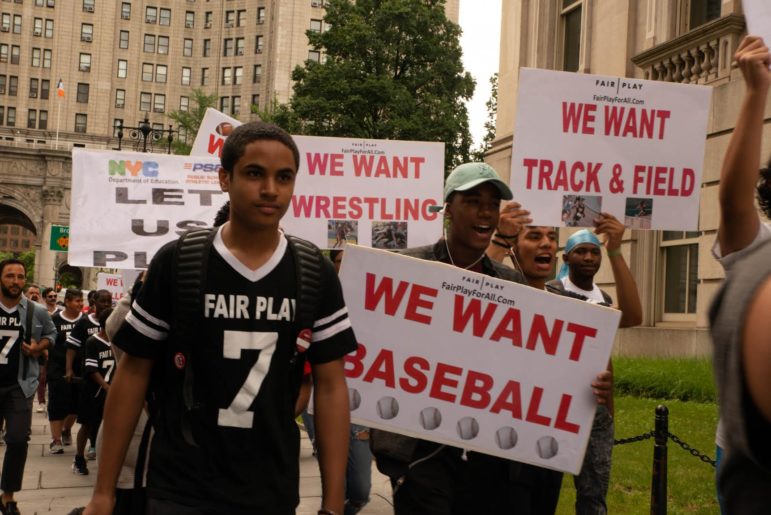
NYLPI
Matt Diaz (wearing No. 7) at a recent rally supporting the lawsuit over access to sports in city schools.
As a Puerto Rican student in the South Bronx, I wasn’t always aware that the resources available to me were not the same as those available to students all over New York City. I first realized there was a big difference between opportunities given to students by race when I took an elective class at my school, Urban Assembly Bronx Academy of Letters, titled “Integrate NYC for me.”
We learned about the Public Schools Athletic League and the dozens of sports teams that a school could have. We looked at data about the inequality of distribution of sports in New York city schools. What stuck out to me the most was how many students don’t have any sports teams in the spring semester. As someone who has always loved sports, I was amazed that the New York City high school with the most White students had 44 teams, while my school had only four. This shock quickly turned to anger, and inspired me to advocate for more sports teams at my school and for all Black and Latino students in New York City.
This class turned into IntegrateNYC, a youth-led organization that fights for school integration and equity. I was so frustrated with the distribution of sports in New York City schools that I wanted to be part of the Resources Committee in IntegrateNYC. I felt it was important for every student to have resources in their school, and especially my school. When I was collecting student stories about resource distribution, I heard a student share that they played basketball in a “gymatorium” – a gym in their auditorium. At first it was funny. I had never heard that word, and all I was thinking about was “how?!” Most auditoriums have a slanted floor, so the ball would roll downhill every time they tried to shoot it and they would have to run uphill to score. But then, I was really frustrated. Do white kids have to play in a gymatorium?
Hearing many stories from my student peers made me want to fight for Black and Latino sports access. At IntegrateNYC, we stand for equitable resources. Cafeteria equipment, music and arts programs, guidance counsellors—all of these are still not equal in our segregated schools. Sports are also still not equal.
Sports make me feel closer to my community and to my family. I remember growing up playing volleyball with my cousins and having to bring my “A” game because they were older than me. My cousins were really good because they had the opportunity to play for teams in Puerto Rico. However, in New York City I am denied that opportunity to play for a volleyball team.
Through my work with IntegrateNYC I have become involved with the FairPlay coalition. At the monthly meetings I always feel this burden of disappointment every time I hear someone not having the opportunity to play high-school sports. I met Lisa Parks at one of these meetings when she shared how much track meant to her when she lived in Atlanta. She shared memories of her mother cheering her on at track meets and the pride she felt when she would bring medals and trophies home. She also shared the shock she felt when she moved to New York City this year and found out her high school did not have any track teams.
Every time I hear one of these stories I am moved to do something about it, advocate, and show all our leaders the Black and Brown reality. Every year segregated high schools ask the PSAL for more sports teams and are denied. Why is that allowed to happen? My fellow student leaders and I at IntegrateNYC, represented by New York Lawyers for the Public Interest, are suing the New York City Department of Education in the hopes that it will work with us to make a plan to fix the unequal distribution of sports teams across the city.
I want all Black and Latino students to be able to play all sports offered by the PSAL and I want that to happen now.
Matt Diaz is going into his senior year at Urban Assembly Bronx Academy of Letters.









5 thoughts on “CityViews: Why NYC Schools Need Sports Equity”
Pingback: – Suit: Black and Latino Students Deprived of Sports Equity
Good for these students. Before mayor Bloomberg broke up the schools most high schools had sports teams and activities including schools bands and lots of cultural enrichment activities. With the break ups came the destruction of the teams because the smaller created schools did not have enough kids to form a team. Some schools housed in the same large bldg formed campus teams. Good for these students and the associations assisting them.
Pingback: NYLPI Making The News | New York Lawyers for the Public Interest
Thanks for an enlightening and timely article. Is tennis offered at any of the city’s public high schools? Has it ever been offered? Thank you.
Pingback: Student Engagement & Advocacy « The National Coalition on School Diversity